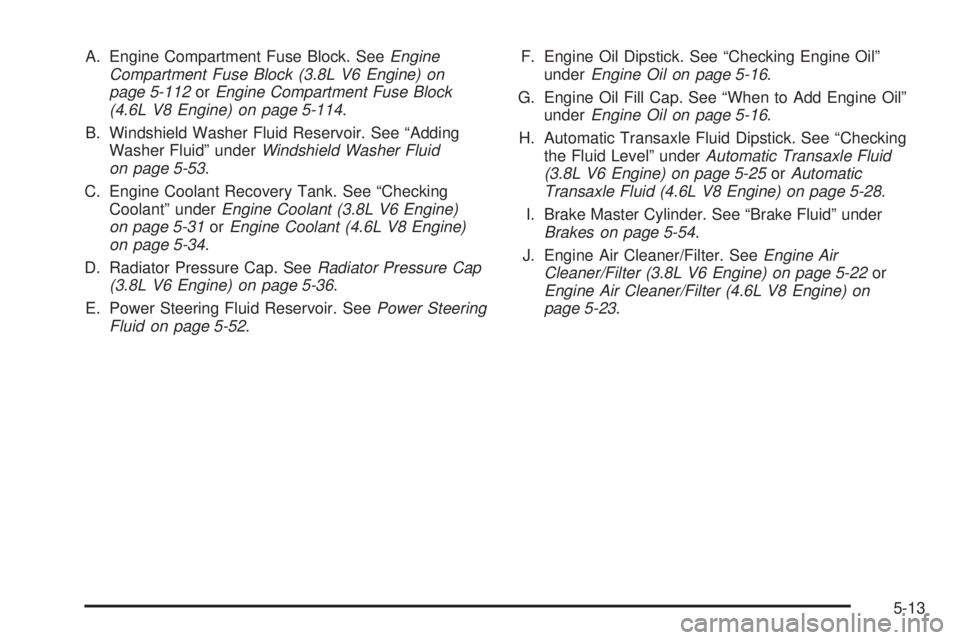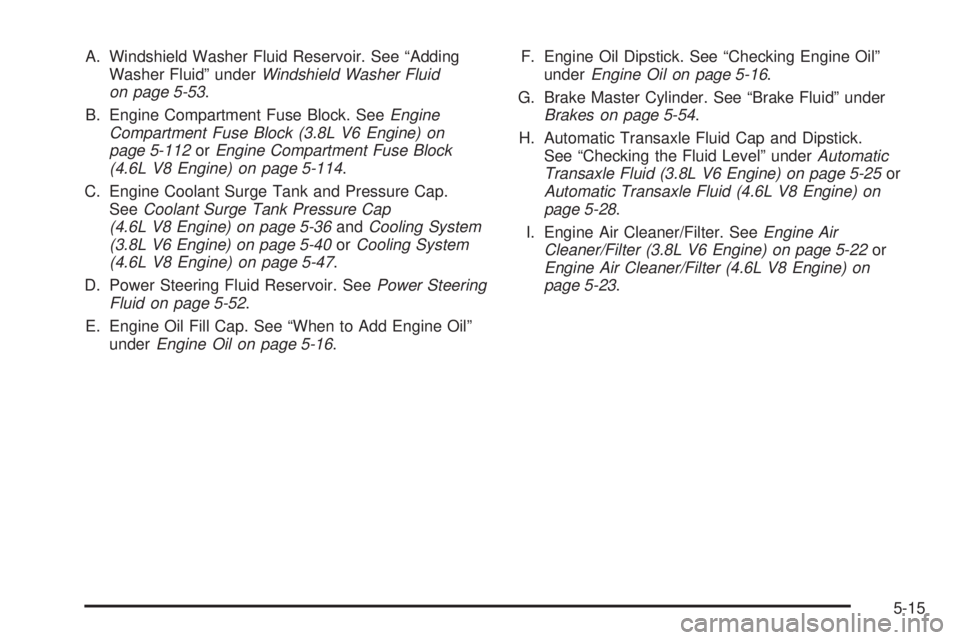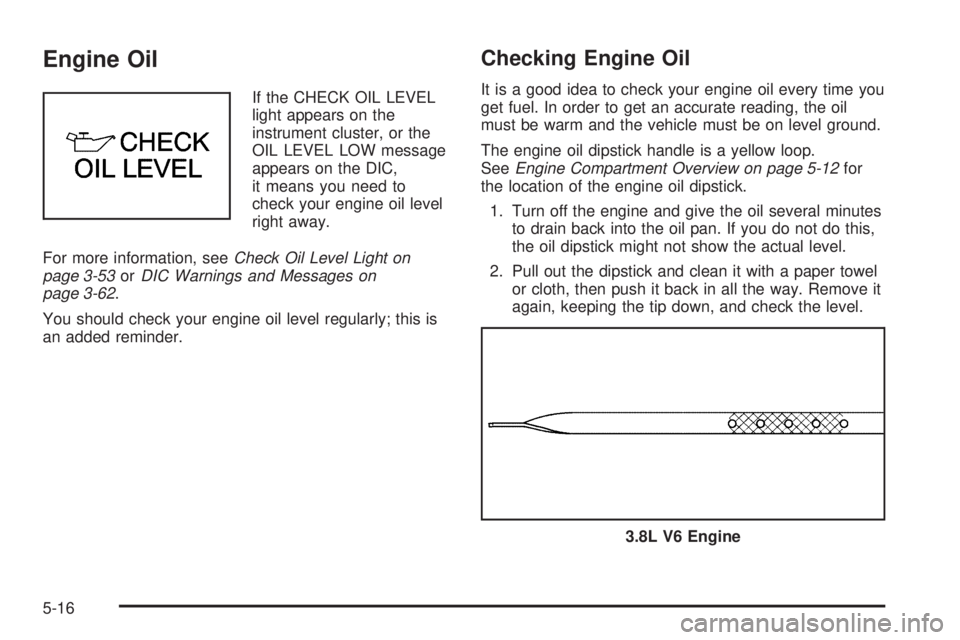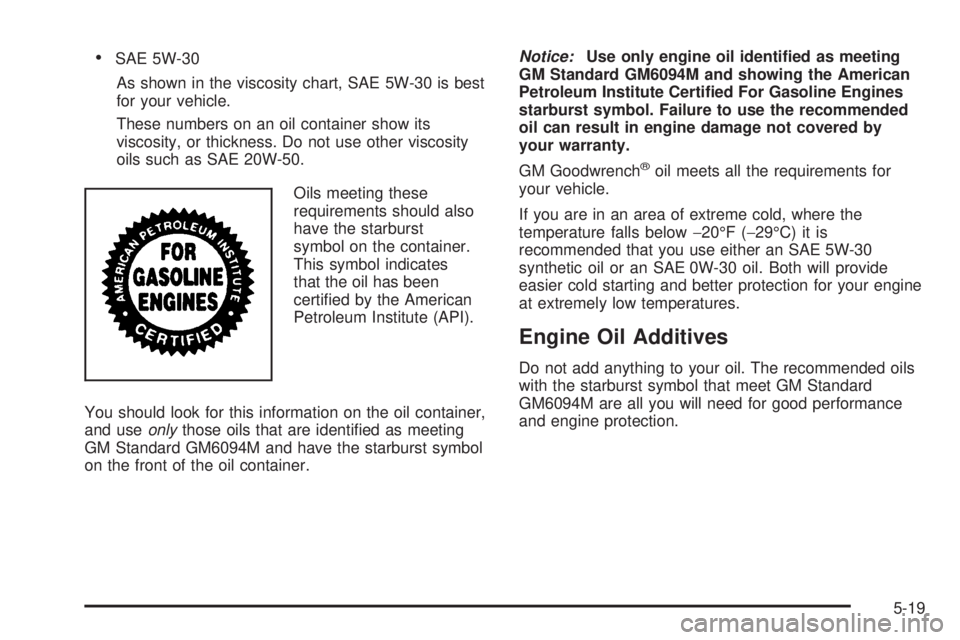Page 272 of 438
Engine Compartment Overview
When you open the hood on the 3.8L V6 engine, here is what you will see:
5-12
Page 273 of 438

A. Engine Compartment Fuse Block. SeeEngine
Compartment Fuse Block (3.8L V6 Engine) on
page 5-112orEngine Compartment Fuse Block
(4.6L V8 Engine) on page 5-114.
B. Windshield Washer Fluid Reservoir. See “Adding
Washer Fluid” underWindshield Washer Fluid
on page 5-53.
C. Engine Coolant Recovery Tank. See “Checking
Coolant” underEngine Coolant (3.8L V6 Engine)
on page 5-31orEngine Coolant (4.6L V8 Engine)
on page 5-34.
D. Radiator Pressure Cap. SeeRadiator Pressure Cap
(3.8L V6 Engine) on page 5-36.
E. Power Steering Fluid Reservoir. SeePower Steering
Fluid on page 5-52.F. Engine Oil Dipstick. See “Checking Engine Oil”
underEngine Oil on page 5-16.
G. Engine Oil Fill Cap. See “When to Add Engine Oil”
underEngine Oil on page 5-16.
H. Automatic Transaxle Fluid Dipstick. See “Checking
the Fluid Level” underAutomatic Transaxle Fluid
(3.8L V6 Engine) on page 5-25orAutomatic
Transaxle Fluid (4.6L V8 Engine) on page 5-28.
I. Brake Master Cylinder. See “Brake Fluid” under
Brakes on page 5-54.
J. Engine Air Cleaner/Filter. SeeEngine Air
Cleaner/Filter (3.8L V6 Engine) on page 5-22or
Engine Air Cleaner/Filter (4.6L V8 Engine) on
page 5-23.
5-13
Page 274 of 438
When you open the hood on the 4.6L V8 engine, here is what you will see:
5-14
Page 275 of 438

A. Windshield Washer Fluid Reservoir. See “Adding
Washer Fluid” underWindshield Washer Fluid
on page 5-53.
B. Engine Compartment Fuse Block. SeeEngine
Compartment Fuse Block (3.8L V6 Engine) on
page 5-112orEngine Compartment Fuse Block
(4.6L V8 Engine) on page 5-114.
C. Engine Coolant Surge Tank and Pressure Cap.
SeeCoolant Surge Tank Pressure Cap
(4.6L V8 Engine) on page 5-36andCooling System
(3.8L V6 Engine) on page 5-40orCooling System
(4.6L V8 Engine) on page 5-47.
D. Power Steering Fluid Reservoir. SeePower Steering
Fluid on page 5-52.
E. Engine Oil Fill Cap. See “When to Add Engine Oil”
underEngine Oil on page 5-16.F. Engine Oil Dipstick. See “Checking Engine Oil”
underEngine Oil on page 5-16.
G. Brake Master Cylinder. See “Brake Fluid” under
Brakes on page 5-54.
H. Automatic Transaxle Fluid Cap and Dipstick.
See “Checking the Fluid Level” underAutomatic
Transaxle Fluid (3.8L V6 Engine) on page 5-25or
Automatic Transaxle Fluid (4.6L V8 Engine) on
page 5-28.
I. Engine Air Cleaner/Filter. SeeEngine Air
Cleaner/Filter (3.8L V6 Engine) on page 5-22or
Engine Air Cleaner/Filter (4.6L V8 Engine) on
page 5-23.
5-15
Page 276 of 438

Engine Oil
If the CHECK OIL LEVEL
light appears on the
instrument cluster, or the
OIL LEVEL LOW message
appears on the DIC,
it means you need to
check your engine oil level
right away.
For more information, seeCheck Oil Level Light on
page 3-53orDIC Warnings and Messages on
page 3-62.
You should check your engine oil level regularly; this is
an added reminder.
Checking Engine Oil
It is a good idea to check your engine oil every time you
get fuel. In order to get an accurate reading, the oil
must be warm and the vehicle must be on level ground.
The engine oil dipstick handle is a yellow loop.
SeeEngine Compartment Overview on page 5-12for
the location of the engine oil dipstick.
1. Turn off the engine and give the oil several minutes
to drain back into the oil pan. If you do not do this,
the oil dipstick might not show the actual level.
2. Pull out the dipstick and clean it with a paper towel
or cloth, then push it back in all the way. Remove it
again, keeping the tip down, and check the level.
3.8L V6 Engine
5-16
Page 277 of 438
When to Add Engine Oil
If the oil is at or below the cross-hatched area at the tip
of the dipstick, then you will need to add at least one
quart of oil. But you must use the right kind. This section
explains what kind of oil to use. For engine oil
crankcase capacity, seeCapacities and Speci�cations
on page 5-121.
Notice:Do not add too much oil. If your engine has
so much oil that the oil level gets above the
cross-hatched area that shows the proper operating
range, your engine could be damaged.SeeEngine Compartment
Overview on page 5-12
for the location of the
engine oil �ll cap.
Be sure to add enough oil to put the level somewhere in
the proper operating range in the cross-hatched area.
Push the dipstick all the way back in when you are
through. 4.6L V8 Engine
5-17
Page 278 of 438
What Kind of Engine Oil to Use
Look for two things:
GM6094M
Your vehicle’s engine requires oil meeting GM
Standard GM6094M. You should look for and use
only an oil that meets GM Standard GM6094M.
5-18
Page 279 of 438

SAE 5W-30
As shown in the viscosity chart, SAE 5W-30 is best
for your vehicle.
These numbers on an oil container show its
viscosity, or thickness. Do not use other viscosity
oils such as SAE 20W-50.
Oils meeting these
requirements should also
have the starburst
symbol on the container.
This symbol indicates
that the oil has been
certi�ed by the American
Petroleum Institute (API).
You should look for this information on the oil container,
and useonlythose oils that are identi�ed as meeting
GM Standard GM6094M and have the starburst symbol
on the front of the oil container.Notice:Use only engine oil identi�ed as meeting
GM Standard GM6094M and showing the American
Petroleum Institute Certi�ed For Gasoline Engines
starburst symbol. Failure to use the recommended
oil can result in engine damage not covered by
your warranty.
GM Goodwrench
®oil meets all the requirements for
your vehicle.
If you are in an area of extreme cold, where the
temperature falls below−20°F (−29°C) it is
recommended that you use either an SAE 5W-30
synthetic oil or an SAE 0W-30 oil. Both will provide
easier cold starting and better protection for your engine
at extremely low temperatures.
Engine Oil Additives
Do not add anything to your oil. The recommended oils
with the starburst symbol that meet GM Standard
GM6094M are all you will need for good performance
and engine protection.
5-19